Home security has come a long way from traditional locks and keys. Today, the role of IoT in security systems is reshaping how we protect our homes. The Internet of Things (IoT) connects devices like cameras, door locks, sensors, and alarms, creating an intelligent ecosystem for home protection. With IoT-enabled surveillance cameras and other smart devices, homeowners can monitor, control, and enhance their security from virtually anywhere.
This blog post dives into the Internet of Things for home protection, explaining how IoT devices improve home security and why they’re a must-have in modern households.
Table of Contents
ToggleWhat Is the Internet of Things (IoT)?
IoT refers to a network of interconnected devices that communicate with each other using the internet. These devices collect, share, and act on data, enabling automation and remote control.
In the context of home security, IoT includes:
- Smart Cameras: Offering live feeds and motion detection.
- Connected Door Locks: Controlled via smartphone apps.
- Motion Sensors: Triggering alerts when unexpected activity is detected.
- Alarm Systems: Integrated with other devices for instant response.
The role of IoT in security systems lies in its ability to create a seamless, intelligent, and responsive network that enhances safety.
How IoT Devices Improve Home Security
1. Remote Monitoring and Control
One of the biggest advantages of IoT-enabled devices is remote accessibility. With a smartphone or tablet, homeowners can:
- View live feeds from IoT-enabled surveillance cameras.
- Lock or unlock doors remotely.
- Receive alerts for unusual activity.
This level of control offers peace of mind, whether you’re at work, on vacation, or simply in another room.
2. Real-Time Alerts and Notifications
IoT devices are equipped with sensors that detect anomalies and send instant alerts. For example:
- Motion sensors notify you of movement in restricted areas.
- Doorbell cameras alert you when someone is at your doorstep.
These real-time updates allow for swift action, minimizing potential risks.
3. Advanced Surveillance Capabilities
IoT-enabled surveillance cameras come with cutting-edge features like:
- High-definition video quality.
- Night vision for 24/7 monitoring.
- Two-way audio for communication with visitors or intruders.
- Cloud storage for easy access to recorded footage.
These features make surveillance more effective and user-friendly.
4. Integration with Smart Home Systems
IoT security devices integrate seamlessly with other smart home technologies. For instance:
- Pairing cameras with smart lighting to illuminate areas when motion is detected.
- Linking door locks with alarm systems to activate a siren if unauthorized access is attempted.
- Syncing with virtual assistants like Alexa or Google Assistant for voice commands.
This interconnected system ensures a holistic approach to home protection.
5. Enhanced Data Analysis and Automation
IoT devices use AI and machine learning to analyze data and improve efficiency. For example:
- Cameras can distinguish between humans, pets, and objects, reducing false alarms.
- Smart systems can learn your routine and adjust settings automatically, like arming the security system when you leave home.
The Role of IoT in Security Systems: Key Devices
1. IoT-Enabled Surveillance Cameras
These cameras provide live monitoring, motion alerts, and cloud storage. Many models also include facial recognition for added security.
2. Smart Door Locks
Control who enters your home with keyless locks that work via smartphone apps or biometric scans.
3. Motion Sensors
These devices detect unusual movement and trigger alarms or notifications.
4. Smart Doorbells
Equipped with cameras and two-way communication, they let you see and talk to visitors remotely.
5. Environmental Sensors
IoT devices can also monitor environmental factors like smoke, carbon monoxide, and water leaks, adding an extra layer of safety.
Benefits of IoT for Home Protection
- Convenience: Manage your security system from anywhere.
- Customization: Tailor settings to your specific needs.
- Cost-Effectiveness: Save on professional security services.
- Scalability: Easily add new devices as needed.
- Peace of Mind: Always stay connected to your home.
Challenges and Considerations
While IoT devices revolutionize home security, they come with challenges:
- Cybersecurity Risks: Protect your system with strong passwords and regular updates to prevent hacking.
- Cost: High-quality IoT devices can be expensive, though they are a long-term investment.
- Complexity: Setting up and maintaining an IoT system may require technical know-how.
Future of IoT in Home Security
The role of IoT in security systems is expanding rapidly. Innovations like AI-powered surveillance, predictive analytics, and blockchain for enhanced data security are shaping the future of Internet of Things for home protection.
In the coming years, we can expect:
- More affordable IoT devices.
- Enhanced privacy measures.
- Greater interoperability among devices from different manufacturers.
Conclusion
The role of IoT in security systems is transforming home protection, offering unparalleled convenience, efficiency, and safety. From IoT-enabled surveillance cameras to smart locks, these devices empower homeowners to take control of their security like never before.
By investing in IoT, you’re not just protecting your property—you’re embracing the future of intelligent, connected living. Enhance your home security today with IoT and enjoy the peace of mind you deserve.







